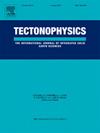Seismotectonic assessment of the High Atlas orogen: Implications for the 8 September Mw 6.8 El-Haouz earthquake
IF 2.7
3区 地球科学
Q2 GEOCHEMISTRY & GEOPHYSICS
引用次数: 0
Abstract
The Moroccan High Atlas is a slowly deforming intracontinental orogenic belt, characterized by moderate and diffuse seismic activity. The 8 September 2023 Mw 6.8 El-Haouz earthquake, one of the most powerful quakes recorded in North Africa, has intensified investigations into the seismotectonics of the High Atlas. This study examines seismotectonic patterns in the High Atlas using seismological and geodetic data to better understand the mechanisms driving such seismic events. Seismological data indicate active shortening in the region, contributing to ongoing mountain building. Present-day deformation is partitioned between thrust and strike-slip faulting, with NW-SE compression, consistent with the broader stress field in North Africa. Frequency-magnitude distribution analysis indicates that the Western High Atlas exhibited low b-values, slightly lower than 1, in the eight years preceding the El-Haouz earthquake, with an low b-value (∼ 0.8 ± 0.1) near the epicenter, suggesting high stress accumulation in the region. GNSS observations reveal that the High Atlas experiences low geodetic velocities compared with the Rif collision belt, with displacements below 1 mm/year. Notably, the axial zone of the Western High Atlas exhibits an uplift of 1.1 mm/yr. The combination of moderate shortening and relatively higher uplift prior to the El-Haouz earthquake suggests that present-day deformation in the Western High Atlas is predominantly accommodated by the reactivation of inherited faults in the axial zone. This is further corroborated by the distribution of aftershocks, which supports a steeply dipping seismogenic fault manifested by the Tizi n'Test Fault.
高阿特拉斯造山带地震构造评价:对9月8日El-Haouz地震的启示
摩洛哥高阿特拉斯是一个缓慢变形的陆内造山带,其特征是中度和扩散性地震活动。2023年9月8日发生的6.8兆瓦El-Haouz地震是北非有记录以来最强烈的地震之一,它加强了对高阿特拉斯地震构造的研究。本研究利用地震学和大地测量数据研究了高地图集的地震构造模式,以更好地了解驱动此类地震事件的机制。地震资料表明,该地区活动缩短,有助于持续造山。现今的变形在逆冲和走滑断裂之间划分,具有北西-东向的挤压作用,与北非更广泛的应力场相一致。频率-震级分布分析表明,在El-Haouz地震发生前8年,西部高地图集的b值较低,略低于1,震中附近的b值较低(~ 0.8±0.1),表明该地区应力积累较高。GNSS观测显示,与裂谷碰撞带相比,高阿特拉斯的大地速度较低,位移低于1毫米/年。值得注意的是,西高地图集的轴向带表现出1.1 mm/yr的隆升。El-Haouz地震前的适度缩短和相对较高的隆升相结合表明,西高阿特拉斯现今的变形主要是由轴带继承断层的重新激活所调节的。余震的分布进一步证实了这一点,这支持了一个陡倾的发震断层,表现为提子试炼断层。
本文章由计算机程序翻译,如有差异,请以英文原文为准。
求助全文
约1分钟内获得全文
求助全文
来源期刊

Tectonophysics
地学-地球化学与地球物理
CiteScore
4.90
自引率
6.90%
发文量
300
审稿时长
6 months
期刊介绍:
The prime focus of Tectonophysics will be high-impact original research and reviews in the fields of kinematics, structure, composition, and dynamics of the solid arth at all scales. Tectonophysics particularly encourages submission of papers based on the integration of a multitude of geophysical, geological, geochemical, geodynamic, and geotectonic methods
 求助内容:
求助内容: 应助结果提醒方式:
应助结果提醒方式:


